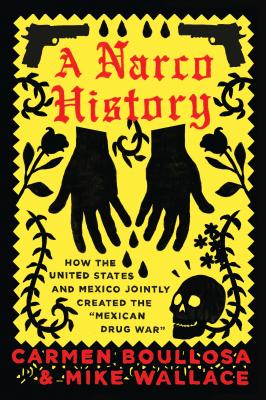A Narco History. Carmen Boullosa
Читать онлайн.| Название | A Narco History |
|---|---|
| Автор произведения | Carmen Boullosa |
| Жанр | Политика, политология |
| Серия | |
| Издательство | Политика, политология |
| Год выпуска | 0 |
| isbn | 9781944869250 |
ebook ISBN 9781944869250
© 2015, 2016 Carmen Boullosa and Mike Wallace
Published for the book trade by OR Books in partnership with Counterpoint Press.
Distributed to the trade by Publishers Group West.
For all rights information: [email protected]
All rights reserved. No part of this book may be reproduced or transmitted in any form or by any means, electronic or mechanical, including photocopy, recording, or any information storage retrieval system, without permission in writing from the publisher, except brief passages for review purposes.
First printing 2015
Cataloging-in-Publication data is available from the Library of Congress.
A catalog record for this book is available from the British Library.
Cover and text design by Bathcat Ltd.
Typeset by AarkMany Media, Chennai, India.
FOR THE DEAD, THE DISAPPEARED,
THE CHILDREN LEFT BEHIND.
CONTENTS
INTRODUCTION: The Forty-Three
1
2
3
4
5
6
7
8
9
10
11
12
ACKNOWLEDGMENTS
BIBLIOGRAPHY
ABOUT THE AUTHORS
Ayotzinapa is a small village, located near the town of Tixtla, in a remote and mountainous region of Guerrero, a state in the south of Mexico. Though best known in the U.S. for its Pacific coast port city of Acapulco, a famed tourist resort since the 1950s and 1960s when stars like John Wayne, Elizabeth Taylor, Frank Sinatra, and Lana Turner flocked there, Guerrero is a poor state, and Ayotzinapa lies in one of its poorest regions.
The village is built around a teacher training school. Its construction dates to 1933, when a colonial-era hacienda was transformed into an institution that aimed to educate the isolated, low-income population of rural Mexico. It was one of a network of “normal schools” imbued with a vision of social justice rooted in the Mexican Revolution (1910–1920). These schools were tasked with educating their students in both literacy and politics: ultimately in creating students who could transform their society. Ayotzinapa’s alumni include two 1950s graduates—Lucio Cabañas and Genaro Vázquez—who became famous leaders of agrarian guerilla insurgencies during the 1960s and 1970s. The school today celebrates this tradition. Its buildings feature murals of Marx and Che and its entryway bears the inscription: “To our fallen comrades, who were not buried, but seeded, to make freedom flourish.”
Much of the radical energy of the 522 students (all male, between eighteen and twenty-four years old, many of Indian descent) goes into preserving the school itself. It has been widely believed that the authorities want to shut it down, along with the other sixteen rural teachers’ schools, despite the fact that roughly a fifth of Guerrero’s 3.4 million citizens do not know how to read or write. Students are given one peso a day (about seven U.S. cents) for their personal expenses, and the funds allotted for meals and housing are skimpy. To survive, the students grow much of their own food, raise chickens, look after dilapidated buildings, and share bare rooms containing more occupants than beds.
Periodically they head into nearby cities and towns to botear—or “pass the can”—to raise money for the school. They also hold demonstrations to push for more funding, and for the creation of more jobs for those who obtain their degree. In 2014, allotments were trending down, and the students were up in arms. “If we don’t demand things, nothing comes,” said one nineteen-year-old student. “We just get leftovers.”
Occasionally they have “borrowed”—forcibly commandeered—commercial buses from national companies. The state doesn’t provide enough vehicles, and it’s a long walk to the schools in remote hill towns where they do their practice teaching, or to the cities where they go to fundraise or demonstrate. More aggressively, they have used the buses to blockade tollbooths along the superhighway that runs from Acapulco north to Mexico City, the nation’s capital; at these temporary barriers they chant protest slogans and demand contributions from infuriated drivers. As these buses (and their drivers) have always been returned, the authorities, to the annoyance of the companies, have basically tolerated the practice.
On Friday afternoon, September 26, 2014, at the end of the second week of classes, roughly a hundred students—almost all freshmen—went on an expedition. Details of the trip’s purpose, its progress, and even its horrific outcome are still unclear, which is amazing considering the national, indeed global attention that has been riveted on it. Nearly every aspect of what happened that day is contested—partly due to the usual Rashomon effect of contradictory
